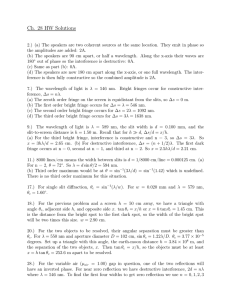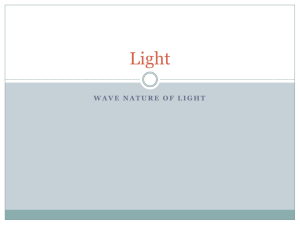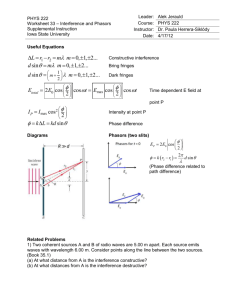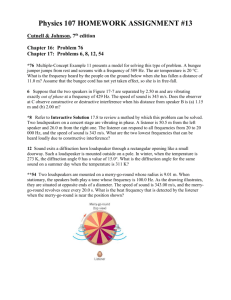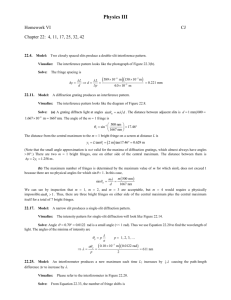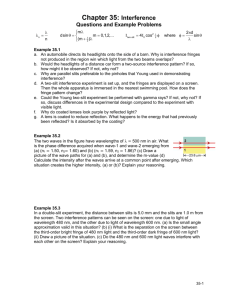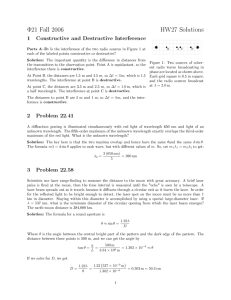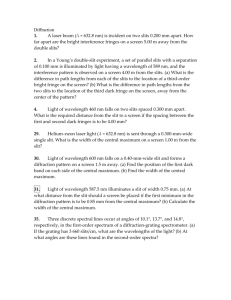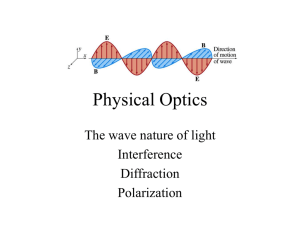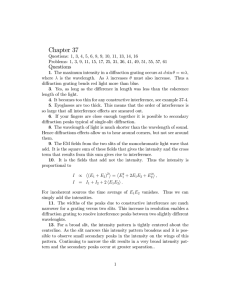Exercise 6 Solution
advertisement
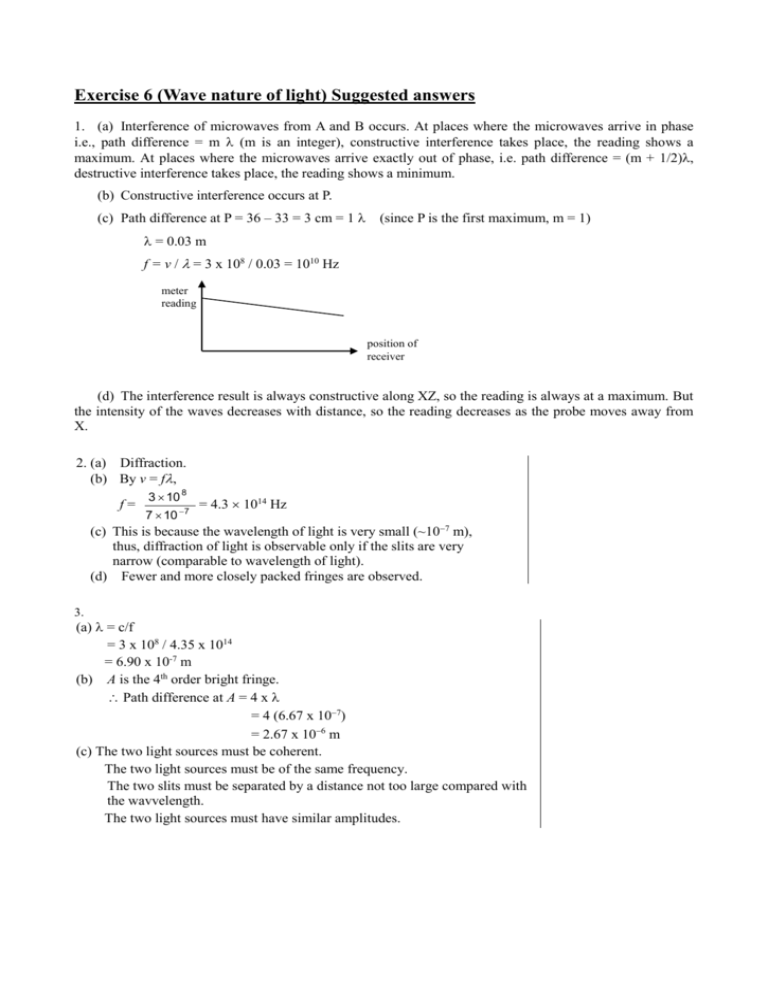
Exercise 6 (Wave nature of light) Suggested answers 1. (a) Interference of microwaves from A and B occurs. At places where the microwaves arrive in phase i.e., path difference = m (m is an integer), constructive interference takes place, the reading shows a maximum. At places where the microwaves arrive exactly out of phase, i.e. path difference = (m + 1/2), destructive interference takes place, the reading shows a minimum. (b) Constructive interference occurs at P. (c) Path difference at P = 36 – 33 = 3 cm = 1 (since P is the first maximum, m = 1) = 0.03 m f = v / = 3 x 108 / 0.03 = 1010 Hz meter reading position of receiver (d) The interference result is always constructive along XZ, so the reading is always at a maximum. But the intensity of the waves decreases with distance, so the reading decreases as the probe moves away from X. 2. (a) Diffraction. (b) By v = f, f= 3 10 8 7 10 7 = 4.3 1014 Hz (c) This is because the wavelength of light is very small (~107 m), thus, diffraction of light is observable only if the slits are very narrow (comparable to wavelength of light). (d) Fewer and more closely packed fringes are observed. 3. (a) = c/f = 3 x 108 / 4.35 x 1014 = 6.90 x 10-7 m (b) A is the 4th order bright fringe. Path difference at A = 4 x = 4 (6.67 x 107) = 2.67 x 106 m (c) The two light sources must be coherent. The two light sources must be of the same frequency. The two slits must be separated by a distance not too large compared with the wavvelength. The two light sources must have similar amplitudes. 4. (a) The distance between successive fringes is y 0.01 5 10 3 m 2 (0.3) 3 Applying y D , 5 10 (2.5 10 5 ) a 4.167 10 7 4.17 10 7 m (b) Let λ′ be the wavelength in air. Applying y 8 10 3 D a , (0.3) (2.5 10 5 ) 6.667 10 7 m refractive index (6.667 10 7 ) 1.6 (4.167 10 7 ) (c) (i) increase the slit separation (ii) decrease the slit-to-screen distance (d) The wavelength should be decreased. (e) Two identical light sources will never produce an interference pattern because the emission of light from ordinary light source is random. There is no definite and stable phase relationship between the light waves coming from the sources, so the light from two separate sources is incoherent, i.e. the phase difference changes from time to time. As a result, the interference is sometimes constructive and sometimes destructive. Thus, no stable interference pattern is observed. 5. (a) By y = = λD , a ay D In this case, a = x m, y = y m, D = 1 m. Therefore, in numerical values, = xy (b) Wavelength of light = xy = 0.11 103 0.5 102 = 5.5 107 m 6. (a) Wavelength of light X in a vacuum = v f = 3 10 8 6.25 10 14 = 4.8 107 m (b) (i) At the 0th order fringe (ii) Grating spacing = 1 10 2 = 2.86 106 m (1M) 3500 By d sin = n, 2.86 106 sin = 4 4.8 107 = 42.2 Distance of the 4th order fringe from the 0th order fringe = 0.4 tan 42.2 = 0.363 m The region is about 0.363 m away from the centre of the interference pattern. (iii) Light Y also produces bright fringe in the region stated in (b)(ii). Apply d sin = n, 2.86 106 sin 42.2 = 3 = 6.40 107 m = 640 nm The wavelength of light Y is 640 nm. 7. (a) sin 30o / sin r = 1/1.5 => r = 48.6o So required angle = 41.4o 8 -7 14 (b) f = c/ = 3 x 10 / 4 x 10 = 7.5 x 10 Hz (c) Ultraviolet (d) Cause fluorescent material to glow (e) Sterilize drinking water / check banknotes (f) sin 30o / sin rR = 1/1.51 => r = 49.025o sin 30o / sin rV = 1/1.53 => r = 49.907o Required angular separation = 49.907o - 49.025o = 0.882o 8. (a) Constructive interference occurs at P 1A because the path difference at P is zero. 1A (b) At Y, path difference = 1.5 = 1.5 x 4 x 10-7 = 6.0 x 10-7 m 1A At Z, path difference = = 4 x 10-7 m 1A (c) The slits serve as coherent sources so that interference fringes can be observed on the screen. (d) f = v / = 3 x 108 / 4 x 10-7 1M = 7.5 x 1014 Hz 1A (e) Ultraviolet 1A (f) (i) It causes fluoresce. 1A (ii) Check banknotes, sterilize drinking water. MC 1-5 A C D C A 6-10 B B A C A 11-15 E D E E D 2A 16-20 A B B C D 21-24 D B C C 2. In glass, both red light and blue light travel slower than in air. But the decrease in speed for red light is smaller, i.e. speed of red light in glass is higher than that of blue. Therefore, red light has less deviation than blue light when travelling through a triangular glass prism. So (1) is correct. In air, red light and blue light have the same speed in air. (2) is correct. In air, red light has a longer wavelength and so lower frequency than blue light. Hence (3) is incorrect. 3. Diffraction and interference are evidence of wave. 6. Frequency is unchanged during refraction. 20. tan = 300 / 400 = 3/4 => sin = 3/5 a sin = m => a (3/5) = 2 => a = 10/3 D 7 10 7 0.5 0.0117m a 3 10 5 Required order = 0.0467 / 0.0117 =4.003 21. s
